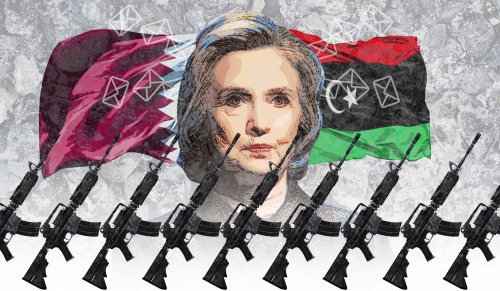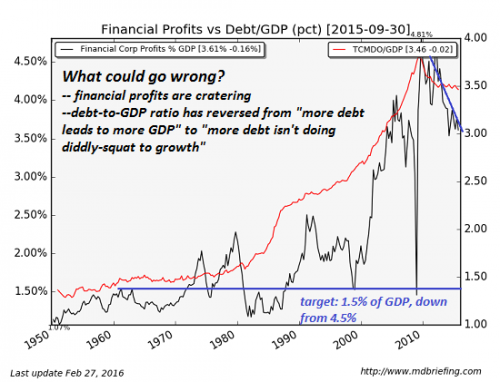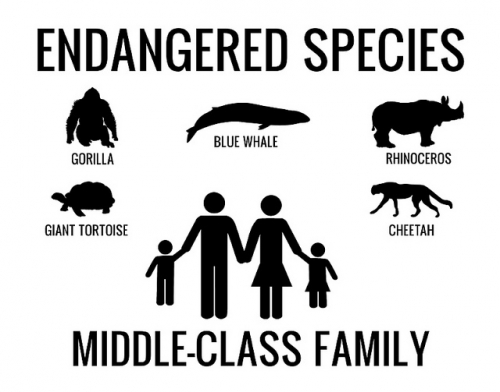mardi, 08 mars 2016
America's Ruling Classes: No Fear, No Caution, No Prudence

America's Ruling Classes: No Fear, No Caution, No Prudence
Charles Hugh Smith
Ex: http://www.oftwominds.com
Could it be that America's ruling classes, its Imperial state and the Federal Reserve, no longer rule their own destiny?
America's smug ruling classes are supremely confident: they feel no fear, no caution, and exhibit no prudence.
I outlined the five ruling classes in America's Nine Classes: The New Class Hierarchy.
The Deep State is confident that its Imperial toady Hillary Clinton will win the election, beating the Upstart Crow, paving a smooth path to unhindered Imperial entanglements around the world. Hillary never saw an Imperial entanglement she didn't like, and her track record of abysmal failure doesn't faze her.

The Obama Administration, from the president on down, are confident their thin legacy will remain untarnished, and will provide them a cash-out in the tens of millions in book advances, speaking fees, and all the other rewards that flow to those who served the Financial Oligarchy and the Deep State.
The Financial Oligarchy is also supremely confident. Obama's complete surrender to the Oligarchy in 2009 enabled a vast expansion of their wealth and power, and Goldman Sachs Hillary stands ready to do her masters' bidding.
The New Nobility (everyone between the .001% and the .05%) is also confident that the Federal Reserve will continue inflating their private wealth by whatever means are necessary--up to and including expropriation of middle class savings via zero interest rate policy and other financial tyranny.
The Upper Caste of technocrats that have skimmed billions in government contracts and stock options in Silicon Valley's Unicorn era are also supremely confident: thanks to the Federal Reserve, they can borrow money for essentially zero interest and use the free money to buy back millions of shares, boosting their own private wealth immensely.
The flim-flam of "innovation" will continue to sell their shares and their gadgets, and their dominance of New Media guarantees they have a lock on the devilishly effective soma of distraction, social media, mindless mobile gaming, etc. that persuades the debt-serf masses that they love their servitude.
The State Nomenklatura is also smugly confident that their privileged spot at the bloated Federal trough of trillions is guaranteed: wealthy lobbyists are buying multi-million dollar McMansions in the cultural wastelands of Northern Virginia (the gaudy ugliness of the homes matching the pretensions of the Nomenklatura), contractors are billing taxpayers billions for questionable services to the National Security State, and public union employees are confident that the Federal government will bail out their unaffordable pension and benefits plans once their local Democratic machines have stripmined the taxpayers and bankrupted what's left of the local government.
This is hubris on an unimaginable scale. If there was any karmic justice in this Universe, all these classes would be ground into the dust of an era that they thought would last forever--an era doomed by their smug confidence that nothing could ever threaten their privileges, wealth and power.
Here's an interesting chart (courtesy of mdbriefing.com) of financial profits as a percentage of GDP and the ratio of debt to GDP. In the virtuous cycle of rapidly expanding financialization/credit, expanding debt pushes growth as measured by GDP (a misleading measure, but that's another story).
The cycle has reversed and is now unvirtuous: more debt is not pushing GDP higher, hence the declining ratio. Adding debt is not generating growth. Diminishing returns have grabbed the parasitic, predatory monster of financialization by its surprisingly vulnerable neck.
Meanwhile, financial profits are cratering. Wait, how could this be happening? Where's the Federal Reserve? Wave your wands, do some more magic!

Could it be that America's ruling classes, its Imperial state and the Federal Reserve, no longer rule their own destiny? Could their smug confidence be their undoing?
Only two things could upset the ruling class apple cart: a financial crash that the Fed can't stop, much less reverse, and Donald Trump winning the presidency.
00:05 Publié dans Actualité, Sociologie | Lien permanent | Commentaires (0) | Tags : actualité, sociologie, élites américaines, états-unis, hiérarchie sociale américaine |  |
|  del.icio.us |
del.icio.us |  |
|  Digg |
Digg | ![]() Facebook
Facebook
lundi, 07 mars 2016
America's Nine Classes: The New Class Hierarchy

America's Nine Classes: The New Class Hierarchy
Charles Hugh Smith
Ex: http://www.oftwominds.com
Eight of the nine classes are hidebound by conventions, neofeudal and neocolonial arrangements and a variety of false choices.
There are many ways to slice and dice America's power/wealth hierarchy. The conventional class structure is divided along the lines of income, i.e. the wealthy, upper middle class, middle class, lower middle class and the poor.
I've suggested that a more useful scheme is to view America through the lens not just of income but of political power and state dependency, as a Three-and-a-Half Class Society (October 22, 2012):
The three-and-a-half class society is comprised of: the "entrenched incumbents" on top (the "half class"), the high-earners who pay most of the taxes (the first class), the working poor who pay Social Security payroll taxes and sales taxes (the second class), and State dependents who pay nothing (the third class).This class structure has political ramifications. In effect, those paying most of the tax are in a pressure cooker: the lid is sealed by the "entrenched incumbents" on top, and the fire beneath is the Central State's insatiable need for more tax revenues to support the entrenched incumbents and its growing army of dependents.
A recent Foreign Policy article on China's New Class Hierarchy: A Guide inspired me to assemble America's nine classes.
1. The Deep State. Mike Lofgren offered this description of the Deep State in Anatomy of the Deep State:
The Deep State is a hybrid association of elements of government and parts of top-level finance and industry that is effectively able to govern the nation without reference to the consent of the governed as expressed through the formal political process.
I describe the U.S. Deep State as the National Security State which enables a vast Imperial structure that incorporates hard and soft power--military, diplomatic, intelligence, finance, commercial, energy, media, higher education--in a system of global dominance.
The key feature of the Deep State is that it makes decisions behind closed doors that the surface government ratifies and implements.
The number of people in the Deep State class is small: senior Federal officials (NSA, Pentagon, State, Treasury, etc.), Executive Branch officials and key private-sector players.
Membership in the Deep State class is not dependent on wealth so much as on relationships and power.
2. The Oligarchs. Oligarchy is in the news--for example We're Headed for Oligarchy--and a number of descriptors are somewhat interchangeable: corporatocracy, plutocracy, etc. I have used Financial Aristocracy to invoke the neofeudal structure of our economy.
Whatever word you prefer, this small class is more or less the top .01% who owns a majority of the nation's financial wealth. They essentially own the political machinery of the nation, writing the rules of legislation that is supposedly regulating their industries, taxes, etc.
3. New Nobility. This is the super-wealthy class just below the Oligarchs. They own a singificant percentage of all assets but do not directly manage the political process like the Oligarch class. They hire lobbyists to protect their interests and constitute an influential political-financial class with global connections.
4. Upper Caste. I use this term to describe the technocrat/professional class that manages the Status Quo for the upper classes. They serve in both government and the private sector.
5. State Nomenklatura. In the Soviet Union, the Nomenklatura were the key administrators in all sectors. In the U.S., the Nomenklatura are well-paid government administrators with security and power. Collectively, they administer their own share of the swag, gaming the system to maximize their pensions, benefits, etc.
Together, the Upper Caste and the Nomenklatura comprise about 9% of the 121 million households in the U.S.: roughly 8.7 million households who earn between $145,000 and $250,000 annually. This class is the bulk of the top 7%, i.e. the top 90% to 97%. Household income in the United States.
The top level of the Upper Caste (2.8 million households) earns more than $250,000 annually. The Nomenklatura and Upper Caste number in total about 11.5 million households.

6. The Middle Class. While others attempt to define the middle class by income alone (many see a household income of around $50,000 as qualifying), I define the middle class not by income alone but by purchasing power, benefits and assets owned. What Does It Take To Be Middle Class? (December 5, 2013).
By this definition, the middle class is the cohort between 70% and 90%--households earning $80,000 or more. Even this is problematic, because in high-cost cities $80,000 is not enough to sustain middle-class conventions (owning a home, two vehicles, etc.) while it may be ample in lower-cost regions.
This 20% comprises about 24 million households.
The lower middle class--what I define as having some but not all of the attributes of full middle class membership--is the cohort between 50% and 70%--households earning more than $55,000 annually.
This class also comprises about 20% (24 million) of all households.
If you think this is too restrictive, please read my above analysis of middle class membership. It may change your view of what constitutes middle-class.
7. The Working Poor. Roughly 38 million households have earned income but it is not sufficient to secure the basics of middle class life. Many qualify for social welfare programs such as food stamps and Medicaid.
This class is about 30% of all households.
8. State Dependents. Though often labeled "poor," those with minimal legal employment may be living better than the working poor, due to generous social welfare benefits such as Section 8 (housing), Medicaid (healthcare), child care, food stamps, disability, etc., and black-market sources of cash income. This class is comprised of the bottom 20% of households.
9. Mobile Creatives. This is an emerging class that ranges across many income classifications and thus cannot be described by income alone. Some earn Upper Caste incomes, others are Working Poor. This class is self-employed, free-lance, entrepreneural, sole proprietors with adaptive skills. They may collaborate with other Creatives rather than have employees, and may have part-time jobs.
There are roughly 5.5 million incorporated self-employed people in the U.S.; these tend to be professionals such as attorneys, engineers and physicians. These self-employed are generally members of the Upper Caste.
The Mobile Creatives (which include small farmers, craftspeople, independent programmers, etc.) number around 10 million, or 8% of the workforce. I use the word mobile here not to suggest mobility between physical places (though that is one factor in this class's flexibility) but mobility between sectors and ways of earning income.
Members of this class might take a short-term paying gig if the pay and circumstance is attractive, and then return to self-employment. They tend to foster multiple income streams and in general operate by the principle trust the network, not the corporation or the state.
Some members of this class joined the cohort involuntarily, as the result of layoffs; others pursue this livelihood for its freedom, flexibility (important to parents of young children or those caring for elderly parents) and potential for self-expression.
This is the "wild card" class that falls outside all conventional class/income hierarchies. It includes those seeking outlier wealth and those who have chosen voluntary poverty.
Though this class wields little conventional financial or political power, it has a potentially large leadership role in social and technical innovations. This is the 4% Pareto Distribution that can exert outsized influence on the 64%.
The other eight classes are hidebound by conventions, neofeudal and neocolonial arrangements and a variety of false choices and illusions of choice, including democracy itself.
I will end this examination of the Nine Classes of America with this question: which class is having more fun? Your answer may say more about your aspirations and worldview than the class hierarchy itself.
00:05 Publié dans Sociologie | Lien permanent | Commentaires (0) | Tags : sociologie, classes sociales, états-unis, hiérarchie sociale, hiérarchie sociale américaine |  |
|  del.icio.us |
del.icio.us |  |
|  Digg |
Digg | ![]() Facebook
Facebook


